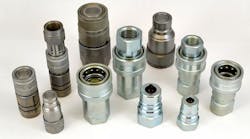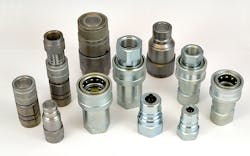All quick-acting couplings have some elements in common. All have two parts: a plug (the male half) and a socket (the female half). When connected properly, they seal and lock the joint to contain internal pressures and resist tensile forces that tend to pull the joint apart. The parts are easily disconnected without tools by disengaging a locking mechanism and separating parts.
The more frequently hoses must be connected and disconnected, the more valuable quick-acting couplings become. They also become more critical as machine productivity increases. On hydraulic test stands, quick-acting couplings eliminate bottlenecks by slashing the time required to test each assembly. Test time is slashed with a quick push/pull, instead of tapping into systems using fittings and a wrench.
Valve arrangements
Among the different designs of quick-acting couplings, either of two types are used for an application. Unvalved types have the advantage of low pressure loss through the coupling but do not prevent fluid from escaping once it is disconnected. However, if pressure drop in the system must be held to a minimum, and fluid draining from disconnected hoses can be tolerated, unvalved couplings could be used.
Obviously, a coupling that does not leak when disconnected is preferred. Incorporating a shutoff valve into one or both halves of the coupling allows fluid to flow through the coupling only when both halves are connected. When the coupling is disconnected, a mechanical link between the coupling halves is broken and causes the valve to close, blocking flow.
Both coupling halves usually are valved, which minimizes fluid leakage and limits the amount of air, dirt, and water that enter the system. When a coupling is disconnected, air can become trapped between valves and enter the system when the joint is reconnected. If the system cannot tolerate air inclusion, special provisions may be needed to exclude air. As a result, many manufacturers offer flat-faced couplings that reduce fluid spillage to a drop or less every time the coupling is disconnected. Mating surfaces of each coupling half are flush when the coupling is disconnected, minimizing air ingression.
Valve considerations
While valved designs offer controlled fluid loss, there are trade-offs. Valved couplings can generate a much higher pressure drop than unvalved designs. The amount of this loss depends on coupling size and design. Pressure drop can be reduced by oversizing the coupling. There also may be some deviation in pressure drop from one coupling design to another.
Other drawbacks to valved couplings include larger size and higher cost. Generally, couplings designed for low pressure drop, no fluid leakage, and no air entrapment carry a higher price tag. The price differential can be offset by higher productivity gained by not having to clean up fluid spills.
Criteria to consider in selection
Before selecting a coupling, its expected performance and fluid medium must be considered. For example, what fluid will flow through the coupling? Characteristics of the fluid — viscosity, corrosiveness — will influence the type of coupling to be used. Other questions concerning fluid deal with temperature (high, low, or wide variation), pressure, and flow rate.
The coupling’s construction shoud also be taken into consideration. How often will it be connected and disconnected? What type and diameter of hose or tubing will be used? Will the coupling or hose be subjected to abuse such as impact from falling objects, severe vibration, or contamination?
Once these questions have been answered, a preliminary selection of coupling can be made: one, two, or no shutoff valves, and the type of connect/disconnect mechanism.
Materials of construction are another consideration. Most O-ring and seal materials accommodate fluids at a wide range of temperatures. Plug and socket material also is important. Steel, stainless steel, and brass are common. Many parts are also made from carbon steel and plated with a corrosion-resistant metal to keep material costs down.
Plastic may be used for fluid transfer if pressure, temperature, and chemical environment permit. Remember that plastic couplings may contain internal metal components that can be corroded by certain hydraulic fluids.
Pressure rating relates to values that provide optimum service life and maximum pressure that can be tolerated without failure. Literature should include data for determining pressure drop through the coupling at expected flows and pressures. Many of these calculations are based on flow of water at 60° F. Remember, pressure drop for oil will be higher because of its higher viscosity. Precise valves for pressure drop for specific couplings should be obtained from the manufacturer.
Couplings may be subjected to pressures well above maximum operating pressure. Sudden shifting of valves or abrupt application of heavy loads can cause system pressure to rise and fall within milliseconds. These pressure spikes often go undetected, but still can damage seals and locking elements of the coupling. The coupling can develop leaks and become difficult to disconnect or reconnect. To prevent this, select a coupling with a pressure rating substantially higher than the anticipated maximum operating pressure.
Couplings may be subjected to vibration or relative rotation between the mating halves while pressurized. Often, these conditions will shorten the coupling’s expected life by causing leakage or difficulties in connecting or disconnecting. Therefore, check with the manufacturer to determine if the coupling will tolerate these conditions.
Below is a list of companies that supply quick-acting couplings.
Airmo Inc., Coon Rapids, MN, (800) 394-0016, www.airmo.com
Automation Direct, Cumming, GA, (800) 633-0405, www.automationdirect.com/aircouplingsCEJN Industrial Corp., Gurnee, IL, (847) 263-7200, www.cejn.com
Colder Products Co., St. Paul, MN, (651) 645-0091, [email protected], www.colder.com
Eaton Corp., Eden Prairie, MN, (952) 937-9800, www.hydraulics.eaton.com
Europower Inc., Valley View, OH, (216) 447-0898, [email protected], www.europowerinc.com
Fairview Fittings & Mfg. Inc., Wheatfield, NY, (716) 614-0320, [email protected], www.fairviewfittings.com
Faster Inc., Maumee, OH, (419) 868-8197, [email protected], www.fasterinc.com
FasTest, St. Paul, MN, (651) 645-6266, [email protected], www.fastestinc.com
Fittings Unlimited Inc., Dallas, TX (817) 861-2651, [email protected], www.fittingsunlimited.com
Force America, Burnsville, MN, (952) 707-1300, [email protected], www.forceamerica.com
Foster Mfg. Co. Inc., Springfield, MO, (417) 881-6600, [email protected], www.couplers.com
Gates Corp., Denver, CO, (303) 744-1911, www.gates.com
Granite Fluid Power, Granite Falls, MN, (320) 564-2311, [email protected], www.gfpmf.com
Hatec International Inc., Houston, TX , (713) 466-6673, [email protected], www.hatecinc.com
Hydraulics Inc., Ft. Worth, TX, (817) 923-1965, [email protected], www.hydraulicsinc.com
Integrated Hydraulics Inc., Mentor, OH, (440) 974-3171, [email protected], www.integratedhydraulics.com
Intertraco (Italia) S.p.A., Suzzara, Italy, +39-0376-539711, [email protected], www.intertraco.it
John Guest USA Inc., Pine Brook, NJ, (973) 808-5600, [email protected], www.jgusa.com
Kurt Hydraulics, Lyman, NE, (308) 787-1211, [email protected], www.kurthydraulics.com
Lenz, Dayton, OH, (937) 277-9364, [email protected], www.lenzinc.com
Manastrip Corp., Rexford, NY, (518) 399-0889, [email protected], www.manastrip.com
Maxbar Inc., Houston, TX, (713) 263-8712, [email protected], www.maxbar.com
Nike Hydraulics Inc., McHenry, IL, (815) 385-7777, [email protected], www.nikehydraulics.com
Parker Hannifin Corp., Energy Products Div., Stafford, TX, (281) 530-5300, [email protected], www.parker.com/epd
Parker Hannifin Corp., Quick Coupling Div., Minneapolis, MN, (763) 544-7781, [email protected], www.parker.com/quickcouplings
Pirtek, Rockledge, FL, (321) 504-4422, [email protected], www.pirtekusa.com
Powertrack International Inc., Pittsburgh, PA, (412) 787-4444, [email protected], powertrackhose.com
Pressure Components Inc., Solon, OH, (440) 349-4020, [email protected], www.pressurecomponents.com
Pressure Connections Corp., Columbus, OH, (614) 863-6930, [email protected], www.pressureconnections.com
Prince Mfg. Corp., N. Sioux City, SD, (605) 235-1220, [email protected], www.princehyd.com
Rectus-TEMA Corp., Randleman, NC, (336) 495-0014, [email protected], www.rectus-tema.com
SafeWay Hydraulics Inc., Chaska, MN, (952) 466-6220, [email protected], www.safewayhyd.com
Simplex, Broadview, IL, (708) 865-1500, [email protected]
Snap-tite Inc., Quick Disconnect & Valve Div., Union City, PA, (814) 438-3821, [email protected], www.snap-tite.com
Spez-Tech Engineered Fluid Power Technology, Mississauga, ON, (905) 828-5579, [email protected], www.speztech.com
Staubli Corp., Connector Div., Duncan, SC, (864) 433-1980, [email protected], www.staubli.com
Stucchi Inc, Romeoville, IL, (847) 956-9720, [email protected], www.stucchiusa.com
TEMA Fluid Connexions Inc., Pt. Huron, MI, (519) 652-0393, [email protected], www.checkfluid.com
Tomco Products Inc. Painesville Twp., OH, (440) 358-1000, www.tomcoquickcouplers.com
Yates Industries Inc., St. Clair Shores, (586) 778-7680, [email protected], www.yatesind.com
ZSI Inc., Canton, MI, (734) 844-0055, [email protected], www.cushaclamp.com


